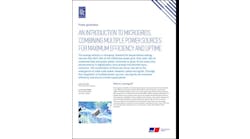By Elisa Wood
October 17, 2008
Wall Street is in the middle of an earthquake. Main Street is shaking from the tremors. Easy Street has been wiped off the map. Is there a safe haven from this economic meltdown? Green Street looks pretty appealing.
Green Street is a term used increasingly to describe businesses that offer energy efficiency, solar, wind and other forms of clean power. While the global economy braces for cost cuts and job loss, Green Street is forecasting profit and massive job creation.
Green Street has been prosperous for while, but its fortunes rose considerably October 3 when President Bush signed into law the $700 billion financial rescue bill.
By way of a series of odd events, the recovery bill included tax credits for clean energy. The credits have nothing to do with the financial rescue, but were attached to the bill at the last minute. Clean energy advocates had been trying to convince Congress to pass the tax incentives for 18 months. Some of the credits had expired; others were about to end; and still others were new to the bill. Before the credits were attached to the recovery bill, clean energy lobbyists in Washington had all but given up on any chance of their passage this year.
What does the bill offer the efficiency industry? Homeowners once again receive tax credits for making a range of efficiency upgrades to their houses. The new law also gives a boost to green commercial buildings, efficient appliances, smart grid technologies and plug-in hybrids. Equally important, it recognizes the efficiency of combined heat and power by offering a new 10% tax credit for small projects. For specifics about the credits see http://www.ase.org/content/article/detail/2654.
A solar conference held this week in San Diego underscored the financial health of Green Street. More than 20,000 people attended. Solar companies described plans for a dramatic increase in rooftop installations, mega solar concentrated power in the southwestern deserts, and manufacturing facilities to equip all of the projects. In all, the solar industry, alone, expects to create nearly a half million jobs as a result of the clean energy tax credits.
This is more good news for energy efficiency, since it is closely aligned with the solar industry. A mantra throughout the solar industry is that efficiency is the first fuel; that is, it is important to first find all cost-effective efficiency in a building, then add solar. In fact, some solar installers help customers finance solar installations with the money they save by cutting back on energy use.
Several factors conspired to cause today’s financial crisis. High oil prices certainly contributed. Energy, the dirty kind, helped get us into this, and energy, the clean kind, will help get us out.
Visit Elisa Wood at www.realenergywriters.com and pick up her free Energy Efficiency Markets podcast and newsletter.





